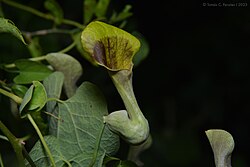Biology:Aristolochia argentina
| Aristolochia argentina | |
|---|---|

| |
| Scientific classification | |
| Kingdom: | Plantae |
| Clade: | Tracheophytes |
| Clade: | Angiosperms |
| Clade: | Magnoliids |
| Order: | Piperales |
| Family: | Aristolochiaceae |
| Genus: | Aristolochia |
| Species: | A. argentina
|
| Binomial name | |
| Aristolochia argentina Griseb.
| |
| Synonyms | |
|
Aristolochia parviflora (Griseb.) Aristolochia glaberrima (Hassl.) | |
Aristolochia argentina is a herbaceous plant in the family Aristolochiaceae. It is native to northern Argentina , Paraguay, and Bolivia.[1][2]
Description
The flowers of A. argentina are zygomorphic. The perianth is a single whorl made up of three fused together green tepals with purple or brown venation. The utricle, tube, and limb are distinguishable, like most other species in this genus. The length of the flower varies between 31-46 millimeters.[3]
Uses
It has been commonly used as there is essential oils from the leaves and can be used as a medicine. Commonly known in Spanish as charrúa, the medicine was found by the GC/MS by hydrodistillation.[4]
The roots of the plant have been used as folk medicine to help with colitis, diarrhoea and hemorrhoids. A study used Aristolochia argentina lyophilized aqueous extract (AALE) and studied the antidiarrhoeal effects on rats and mice. It found that AALE inhibited intestinal motility and enteropooling property, thus having antidiarrhoeal effects.[5]
Distribution and habitat
It was most commonly found in the months of January and February. Around 80% of the time it was found, it was found in Argentina .[2]
Ecology
The flowers of Aristolochia argentina attract scuttle fly pollinators (genus Megaselia). The perianth is made to be a trap for the incests. It produces a oder that mimics some natural processes of the flies. The flies get trapped in there for 24 hours, all while making contact with the flowers sexual organs. After leaving, they can get caught later.[3]
A 2016 study studied the foraging changes of Acromyrmex lundi after being exposed to Aristolochia argentina extract. It was found that the 1% extract had no impact on Acromyrmex lundi, but the 5% dose caused significant changes to the foraging habits of the ant. The 5% dose had a repellency index of above 95%.[6]
References
- ↑ "Aristolochia argentina Griseb. | Plants of the World Online | Kew Science" (in en). http://powo.science.kew.org/taxon/urn:lsid:ipni.org:names:92747-1.
- ↑ 2.0 2.1 "Aristolochia argentina Griseb." (in en). https://www.gbif.org/species/3589002/metrics.
- ↑ 3.0 3.1 Trujillo, Cecilia G.; Sérsic, Alicia N. (2006-08-11). "Floral biology of Aristolochia argentina (Aristolochiaceae)" (in en). Flora - Morphology, Distribution, Functional Ecology of Plants 201 (5): 374–382. doi:10.1016/j.flora.2005.07.013. ISSN 0367-2530. https://www.sciencedirect.com/science/article/pii/S0367253006000223.
- ↑ Priestap, Horacio A.; van Baren, Catalina M.; Di Leo Lira, Paola; Coussio, J. D.; Bandoni, Arnaldo L. (May 2003). "Volatile constituents of Aristolochia argentina". Phytochemistry 63 (2): 221–225. doi:10.1016/s0031-9422(02)00751-3. ISSN 0031-9422. PMID 12711145. https://pubmed.ncbi.nlm.nih.gov/12711145/.
- ↑ Paredes, Jésica D.; Sosa, Ángela; Fusco, María; Teves, Mauricio R.; Wendel, Graciela H.; Pelzer, Lilian E. (1970-01-01). "Antidiarrhoeal activity of Aristolochia argentina Gris. (Aristolochiaceae) in rodents" (in en). Journal of Applied Pharmaceutical Science 6 (2): 146–146. doi:10.7324/JAPS.2016.60223. https://japsonline.com/index.php/?mno=208863.
- ↑ Defagó, María Teresa; Nolli, Laura; Napal, Georgina Díaz; Palacios, Sara María; Buffa, Liliana María (29 Feb 2016). "Can the extract of Aristolochia argentina Griseb affect the foraging decisions of the leaf cutting ant Acromyrmex lundi (Guérin)? Preliminary assays". International Journal of Pest Management 63. https://www.tandfonline.com/doi/full/10.1080/09670874.2017.1327680?scroll=top&needAccess=true&role=tab.
Wikidata ☰ Q15463121 entry
 |

